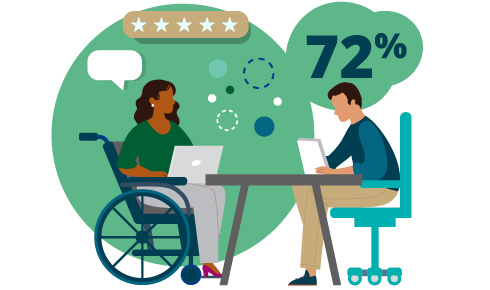Picture this: you have a pool of highly qualified candidates, each bringing unique strengths to the table. How do you ensure that you select the candidate who is the best fit for the role?
The first step is to assess whether or not your organization prioritizes inclusion when selecting a qualified candidate. To attract and retain the highest quality candidates, all employees need to feel valued, respected, and supported regardless of their differences and that starts with the hiring process. Differences can include race, ethnicity, gender, sexual orientation, age, physical abilities, religious beliefs, educational background, neurodiversity, and more. Inclusive workplaces promote diversity and ensure that everyone has equal access to opportunities, resources, and advancement.
The second step is to cultivate inclusive hiring and selection processes that foster a culture that welcomes, hears, and values diverse perspectives. This approach can lead to more confident and effective selection outcomes.
To further understand what organizations are doing to ensure inclusivity in the hiring and selection process, Wiley Workplace Intelligence surveyed 2,400 people, the majority of which are individual contributors and managers. Our research delves into current trends in hiring and selection, examining whether those involved in these processes receive training to reduce bias and what tools are employed to ensure equity. Our findings may surprise you.
Majority Report Using Interviews as the Primary Selection Tool

72% of those in hiring and selection rely on interviews alone for job selection
Our research revealed that a significant majority (72%) of those involved in hiring and selection rely primarily on interviews as their main selection tool. While interviews are a common practice and are a good starting point to get to know a candidate, they can often be imprecise and susceptible to unintentional bias, potentially affecting the fairness and effectiveness of the hiring process. When combined with more objective data, interviews can be a highly effective tool in the hiring process.
Top Five Selection Tools Used in the Hiring Process:
Moreover, our findings highlighted a concerning gap in the use of skills-based and personality assessments, with less than 4% of hiring professionals incorporating them into their decision-making. Skills-based assessments can provide a more objective measure of a candidate’s abilities, helping to mitigate bias and ensure that hiring decisions are based on relevant competencies.
By integrating a variety of assessment tools, including skills-based and personality evaluations, organizations can enhance the inclusivity and accuracy of their hiring processes. This approach not only promotes fairness but also helps identify the best candidates based on their actual skills and potential, leading to a more diverse and skilled workforce.
Hiring and Selection Training Is Typically Provided

72% receive training related to hiring and selection
Our research revealed that 72% of respondents receive some form of training related to hiring and selection, though the specifics of this training remain unclear. This indicates that while a majority of organizations are investing in training, there is still room for improvement in terms of clarity and comprehensiveness. To enhance inclusivity and effectiveness in the hiring process, organizations could implement a variety of targeted training programs. These could include:
- Unconscious Bias Training: Educating employees about the subtle, often unintentional, biases that can influence hiring decisions.
- Diversity and Inclusion Workshops: Promoting a deeper understanding of the value of diverse teams and inclusive practices.
- Behavioral and Skills-Based Assessment Training: Focusing on evaluating candidates based on their skills, behaviors, and competencies rather than subjective criteria.
- Interview Techniques Guidance: Providing best practices for conducting fair and effective interviews.
While HR professionals are typically responsible for understanding and implementing diversity, equity, and inclusion (DE&I) practices at a strategic level, it is equally important for hiring managers to receive comprehensive training. HR departments often bring in a diverse set of candidates into the recruitment pipeline, but the final hiring decision rests with the hiring managers. Therefore, ensuring that hiring managers are equipped with the awareness and resources to support inclusivity is crucial.
Only Half Receive Inclusivity Training

56% receive training on inclusive practices in hiring and selection
According to 56% of surveyed individuals involved in hiring and selection, their organizations provide training or education specifically on inclusive practices in the hiring process. While this is a positive step, it also highlights a significant gap: nearly half of the respondents’ organizations lack such training. This absence poses a potential liability and concern for organizations.
Without inclusion-specific training, hiring processes can inadvertently foster unconscious bias. Relying primarily on interviews without proper training can create blind spots, leading to biased decisions, even if unintentional. These biases can result in a less diverse workforce, which can hinder innovation and growth. Addressing this issue is crucial for fostering a truly inclusive and equitable workplace.
By embedding inclusivity into hiring practices, organizations can attract a wider range of talent, reduce biases, and foster a more dynamic and innovative workforce. This commitment to inclusivity not only enhances creativity and overall success but also builds a workplace where every individual feels valued and supported.
Wiley assessment brands lay the foundation for creating cohesive organizations. Specifically, PXT Select® assessments provide powerful insights, enabling you to make confident, data-backed hiring decisions. This significantly reduces the risk of bias in the hiring and selection process, which is vital to the overall success of your business.